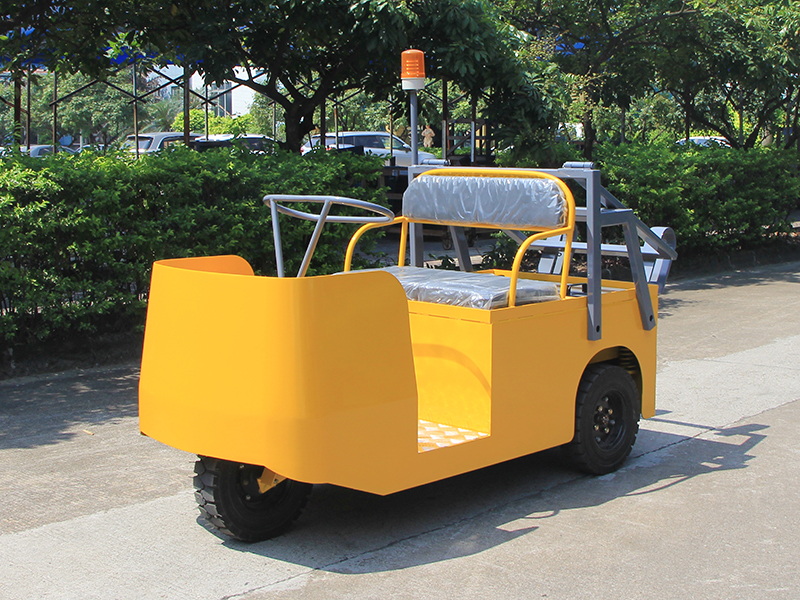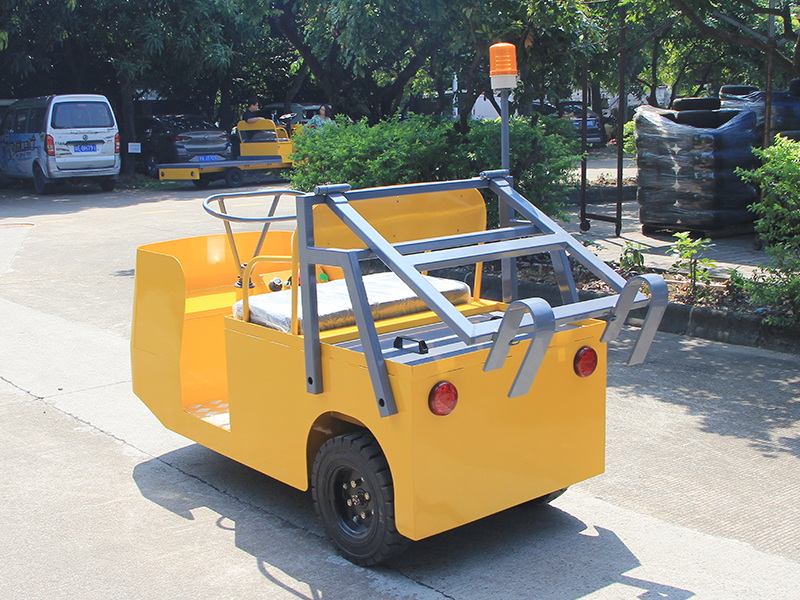Content Menu
● What Are Electric Towing Tractors?
● Environmental Benefits of Electric Towing Tractors
>> Zero Emission Operation
>> Reduction in Greenhouse Gas Emissions
>> Noise Pollution Reduction
● Economic and Operational Advantages
>> Lower Operating and Maintenance Costs
>> Energy Efficiency
>> Versatility and Maneuverability
● Case Studies and Industry Adoption
>> Hong Kong International Airport
>> City of Berkeley, California
>> Agricultural Sector
● Challenges and Considerations
>> Initial Investment and Payback Period
>> Battery Life and Charging Infrastructure
>> Dependence on Electricity Grid Mix
>> Technological and Operational Adaptation
● Future Outlook and Innovations
● Conclusion
● FAQ
>> 1. What are the main environmental benefits of electric towing tractors?
>> 2. How much can electric towing tractors reduce greenhouse gas emissions?
>> 3. Are electric towing tractors cost-effective in the long term?
>> 4. What challenges exist in adopting electric towing tractors?
>> 5. How does the source of electricity affect the sustainability of electric towing tractors?
Electric towing tractors are revolutionizing the way industries handle heavy loads by offering a cleaner, quieter, and more efficient alternative to traditional diesel or gasoline-powered vehicles. As global concerns about climate change and environmental degradation intensify, the adoption of electric towing tractors is becoming a critical component in the journey toward sustainable industrial and agricultural practices. This article delves deeply into how electric towing tractors impact environmental sustainability, exploring their benefits, challenges, and future potential.

What Are Electric Towing Tractors?
Electric towing tractors are specialized battery-powered vehicles designed to tow heavy loads and trailers in various settings such as warehouses, airports, manufacturing plants, and agricultural fields. Unlike conventional tractors that rely on internal combustion engines (ICEs) fueled by diesel or gasoline, electric towing tractors operate on rechargeable batteries, typically lithium-ion or advanced lead-acid types, enabling zero tailpipe emissions.
These tractors come in different sizes and power capacities, ranging from small models used in indoor environments to large, rugged machines capable of handling demanding outdoor agricultural or industrial tasks. Their design prioritizes efficiency, maneuverability, and environmental friendliness, making them an attractive alternative to traditional towing equipment.
Environmental Benefits of Electric Towing Tractors
Zero Emission Operation
One of the most significant environmental advantages of electric towing tractors is their zero-emission operation at the point of use. Unlike diesel or gasoline tractors, electric models do not emit harmful pollutants such as nitrogen oxides (NOx), volatile organic compounds (VOCs), carbon monoxide (CO), or particulate matter (PM). This is especially critical in enclosed or semi-enclosed environments like warehouses or airports, where air quality directly affects worker health and safety.
By eliminating tailpipe emissions, electric towing tractors help reduce smog formation, respiratory illnesses, and environmental contamination. This contributes to healthier workplaces and communities, aligning with stricter air quality regulations worldwide.
Reduction in Greenhouse Gas Emissions
Beyond local air quality improvements, electric towing tractors play a vital role in mitigating climate change by reducing greenhouse gas (GHG) emissions. When powered by electricity sourced from renewable energy, these tractors can operate with near-zero carbon footprints.
Even when charged from conventional grids, electric tractors typically produce fewer GHG emissions than diesel-powered alternatives due to the higher efficiency of electric motors and centralized power generation. Life cycle assessments indicate that converting diesel-powered agricultural tractors and industrial towing vehicles to electric can reduce GHG emissions by more than 80% on a well-to-wheel basis.
For example, a medium-sized diesel tractor emits approximately 20 metric tons of CO2 equivalent annually. Replacing it with an electric tractor powered by a moderately clean grid can reduce this to around 4 metric tons or less, depending on the energy mix. Over a fleet of vehicles, these savings translate into substantial contributions toward corporate sustainability goals and national emissions targets.
Noise Pollution Reduction
Electric towing tractors operate much more quietly than their combustion engine counterparts, producing noise levels often below 60 decibels, compared to 85-95 decibels typical of diesel tractors. This noise reduction improves workplace safety by lowering the risk of hearing damage and reduces stress for operators and nearby workers.
In urban or residential-adjacent industrial sites, quieter operations help minimize community disturbance and comply with noise pollution regulations. This benefit is particularly valuable in airports and logistics hubs, where continuous operations often generate significant noise.
Economic and Operational Advantages
Lower Operating and Maintenance Costs
Electric towing tractors offer significant economic advantages, primarily through reduced operating and maintenance costs. Electric motors have fewer moving parts than internal combustion engines, which translates to less frequent repairs and lower maintenance expenses. There is no need for oil changes, fuel filters, spark plugs, or exhaust system repairs.
Additionally, electricity is generally cheaper and more stable in price than diesel or gasoline, leading to predictable and lower fueling costs. Some companies report that electric tractors reduce total cost of ownership by up to 30% over their operational lifespan.
Energy Efficiency
Electric motors are inherently more efficient than combustion engines, converting over 85-90% of electrical energy into mechanical power, compared to 30-40% efficiency for diesel engines. This high efficiency means that electric towing tractors consume less energy per unit of work, reducing overall energy demand.
Furthermore, electric tractors can utilize regenerative braking systems that recover energy during deceleration, further enhancing efficiency and extending battery life.
Versatility and Maneuverability
Electric towing tractors are often designed to be compact and highly maneuverable, making them ideal for navigating tight spaces in warehouses, factories, and airports. Their instant torque delivery allows smooth and precise control, which is essential for delicate material handling tasks.
Many models come with modular attachments and customizable towing capacities, enabling operators to adapt the tractors for various applications, from pallet towing to heavy-duty agricultural hauling.

Case Studies and Industry Adoption
Hong Kong International Airport
Hong Kong International Airport (HKIA) has integrated electric towing tractors into its ground support equipment fleet as part of a comprehensive sustainability initiative. The airport's operator, HAECO, reported that each electric tractor could save approximately 165 tonnes of carbon emissions annually compared to diesel tractors. This transition supports the airport's goal to become carbon neutral by 2050 and demonstrates the practical viability of electric towing tractors in high-demand, continuous-operation environments.
City of Berkeley, California
The City of Berkeley has been proactive in replacing gas-powered municipal equipment with electric alternatives, including electric towing tractors like the Monarch MK-V. This initiative aims to improve urban air quality, reduce greenhouse gas emissions, and serve as a model for other municipalities. The electric tractors have proven effective in parks maintenance and waste management operations, showcasing their adaptability and environmental benefits.
Agricultural Sector
In agriculture, electric towing tractors are gaining traction as farmers seek to reduce fuel costs and environmental impact. Electric tractors offer precise control for planting, harvesting, and towing tasks, and their quiet operation benefits livestock and rural communities. Several startups and established manufacturers are developing electric tractors with extended battery ranges and robust power outputs, signaling a growing market shift.
Challenges and Considerations
Initial Investment and Payback Period
One of the main barriers to widespread adoption of electric towing tractors is the higher upfront cost compared to traditional diesel models. Batteries, electric drivetrains, and associated electronics contribute to this premium.
However, when considering total cost of ownership-including fuel savings, lower maintenance, and potential government incentives-the payback period can be as short as 2-4 years depending on usage intensity and electricity prices.
Battery Life and Charging Infrastructure
Battery technology is rapidly advancing, but limitations remain in terms of range, charging time, and battery lifespan. For continuous or heavy-duty operations, adequate charging infrastructure must be in place to avoid downtime.
Fast-charging stations, battery swapping systems, and smart energy management are key solutions being developed to address these challenges. Proper battery recycling and disposal protocols are also critical to ensure environmental benefits throughout the vehicle lifecycle.
Dependence on Electricity Grid Mix
The sustainability of electric towing tractors depends heavily on the source of electricity used for charging. In regions where electricity generation relies on coal or other fossil fuels, the net environmental benefits are reduced.
Transitioning to renewable energy sources such as solar, wind, or hydropower for charging infrastructure maximizes the positive impact of electric tractor adoption. Some companies are integrating on-site renewable energy generation to power their electric fleets, further enhancing sustainability.
Technological and Operational Adaptation
Adopting electric towing tractors may require changes in operational practices, including training for operators and maintenance staff, as well as adjustments in workflow to accommodate charging schedules. Integration with existing fleet management systems and logistics planning is essential to optimize utilization.
Future Outlook and Innovations
The future of electric towing tractors looks promising, driven by advances in battery technology, electric motor efficiency, and digital connectivity. Innovations such as solid-state batteries promise higher energy density and faster charging, potentially extending operational ranges and reducing costs.
Integration with Internet of Things (IoT) platforms enables predictive maintenance, real-time monitoring, and fleet optimization, enhancing productivity and reducing downtime. Autonomous electric towing tractors are also emerging, offering the potential for fully automated material handling in controlled environments.
Government policies and incentives aimed at reducing carbon emissions and promoting clean technologies will likely accelerate the adoption of electric towing tractors globally. As manufacturing scales up and technology matures, prices are expected to decrease, making electric tractors accessible to a broader range of industries and regions.
Conclusion
Electric towing tractors represent a pivotal advancement in sustainable industrial and agricultural transport. By eliminating tailpipe emissions, reducing greenhouse gases, lowering noise pollution, and offering economic advantages through reduced operating costs and enhanced efficiency, they significantly contribute to environmental sustainability.
While challenges such as upfront costs, battery limitations, and infrastructure needs remain, ongoing technological innovations and supportive policies are rapidly overcoming these barriers. The growing adoption of electric towing tractors across airports, warehouses, municipalities, and farms underscores their practical viability and environmental benefits.
Ultimately, electric towing tractors are not just a cleaner alternative-they are a transformative tool helping industries align with global sustainability goals, improve operational efficiency, and foster healthier environments for workers and communities alike.

FAQ
1. What are the main environmental benefits of electric towing tractors?
Electric towing tractors produce zero on-site emissions, significantly reducing air pollutants such as nitrogen oxides, carbon monoxide, and particulate matter. They also reduce greenhouse gas emissions, especially when charged with renewable energy, and operate more quietly, lowering noise pollution.
2. How much can electric towing tractors reduce greenhouse gas emissions?
Electric towing tractors can reduce greenhouse gas emissions by over 80% compared to diesel-powered models on a well-to-wheel basis. The exact reduction depends on the electricity generation mix but typically results in substantial carbon savings.
3. Are electric towing tractors cost-effective in the long term?
Yes. Although electric towing tractors have higher initial purchase prices, they offer lower fuel and maintenance costs, leading to significant savings over their operational lifespan. Payback periods can range from 2 to 4 years depending on usage and energy costs.
4. What challenges exist in adopting electric towing tractors?
Challenges include higher upfront costs, battery range and charging infrastructure requirements, dependence on the electricity grid's cleanliness, and the need for operational adjustments such as training and workflow changes.
5. How does the source of electricity affect the sustainability of electric towing tractors?
The environmental benefits of electric towing tractors are maximized when charged with electricity generated from renewable sources such as solar, wind, or hydro. Charging from fossil-fuel-heavy grids reduces the net emissions savings but still generally results in lower emissions than diesel alternatives.










































